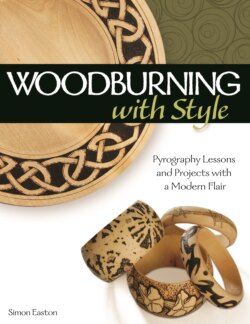Читать книгу Woodburning with Style - Simon Easton - Страница 54
На сайте Литреса книга снята с продажи.
PRACTICE EXERCISE: DRAW A LINE
ОглавлениеThere are a few techniques you can practice in order to learn the basic foundations of working in pyrography. The obvious place to start is with drawing a line.
It would be very difficult to draw a long continuous line across a wooden surface using a pyrography pen. The quality of the surface changes according to the figure, grain, and inherent characteristics of each type of wood. The best way to make a line is in stages. You need to re-position your hand frequently to create a longer line in small sections. Try to work with the natural movement and flow of your wrist, as this is the most comfortable way to write or draw. If you try to pull the pen in a line using the movement of your fingers toward your hand, the range of movement is a lot more limited.
The aim is to get a line that is even in tone, depth, and thickness from one end to the other. Start the line softly and slowly. Gradually introduce the nib to the wood at an angle, rather than pressing it straight down. Many pyrographers relate this process to a plane landing on a runway. Try to move at a steady and even pace across the wood: if you jerk or stop for even a split second, the heat application will be uneven and you will get blobs. When you are ready to remove the nib from the surface, do so like you started the line: lift the nib gradually as you keep moving.
Your first attempt may look uneven or ugly, but that’s the whole point of practicing! The tendency for new pyrographers is to press the nib down vertically and then move sideways, which creates a heavy blobbed effect. Pressing down can gouge the wood heavily, which is hard or impossible to amend. Try to create your lines without altering the surface of the wood, as you would when drawing with a pen or pencil on thin paper. If your lines don’t look smooth and even, take a look at the troubleshooting information here.
Keep making more lines, working down the piece of wood as you go. As you practice, you will see the quality of the line improves as you learn what the nib will do in certain circumstances. You will find you become more confident in controlling the line quality with time and experience until it becomes second nature. You can then try other activities to improve your confidence, such as creating longer lines by joining several shorter sections together.
Draw two parallel tramlines or train tracks on a piece of wood to practice making lines with your pyrography pen. Do not place them too far apart for your initial attempts. Turn the pyrography machine on and set it to a medium temperature if you are using an adjustable base unit.
Try to create lines as smooth as possible, using a range of nibs. You will find some nibs are more suited to creating straight lines than others.
Remember to bring the pyrography pen into contact with the surface gradually to avoid making a blob or heavy burn at the start of a line. Remember to lift the pen off in the same way.
The speed that you move the pen across the wood is also a factor to consider and experiment with. A slower speed means the nib spends more time in contact with the wood making a mark. Moving the nib across the wood at high speed can be used to make light or delicate marks.
Wood features have a vast effect on pyrography, because no two pieces of wood will ever be completely the same. The natural pattern of the figure, grain, and knots can be regarded as flaws, but it is possible to be sensitive to the individual nature of the wood when creating your designs. Whether you consider these features to be flaws or assets, it is a fact that the hardness of the wood, the strength of the grain, knots, and other conditions present in the wood itself have a direct effect on the pyrography. The hard grain itself has a different heat tolerance to the softer wood surrounding it. This means the grain is usually more resistant to the heat applied, and making an even mark can be difficult as a result. It can make your lines appear dotted or uneven. The best way to address this is to practice on a scrap piece wherever possible so you can experiment with the best way to get the required result before moving to your finished piece.
Knots are harder than surrounding areas of wood.
This plate shows the appearance of spalting, which is a natural form of discoloration in the wood caused by fungi. Spalted areas are usually softer than the surrounding wood.
If you are having trouble getting consistent marks due to the grain or figure of the wood, take your time to build up the quality of the line or pattern. Soft grain will burn more readily than hard grain, so you will need to adjust your speed or the nib temperature to compensate for this. Use a lower temperature or a quicker speed across soft areas and the opposite for areas that are harder. If you need to go over an area several times to get the required quality of mark, then it is well worth the extra time and effort to do so rather than burning it too harshly just to save time.
